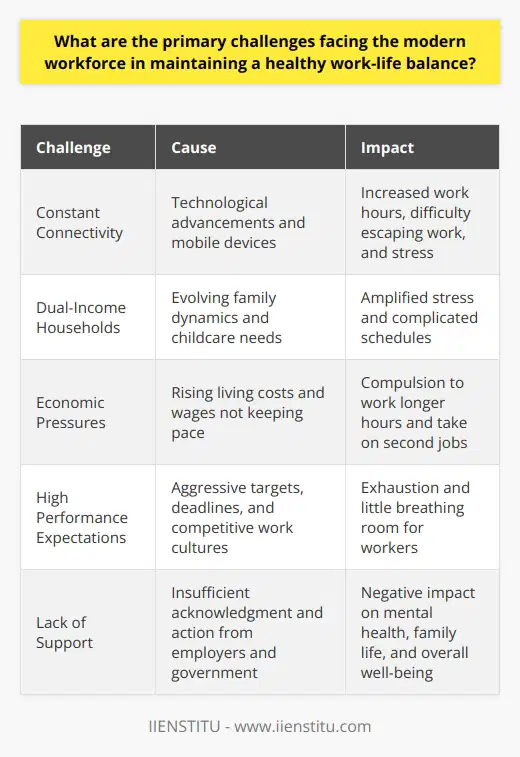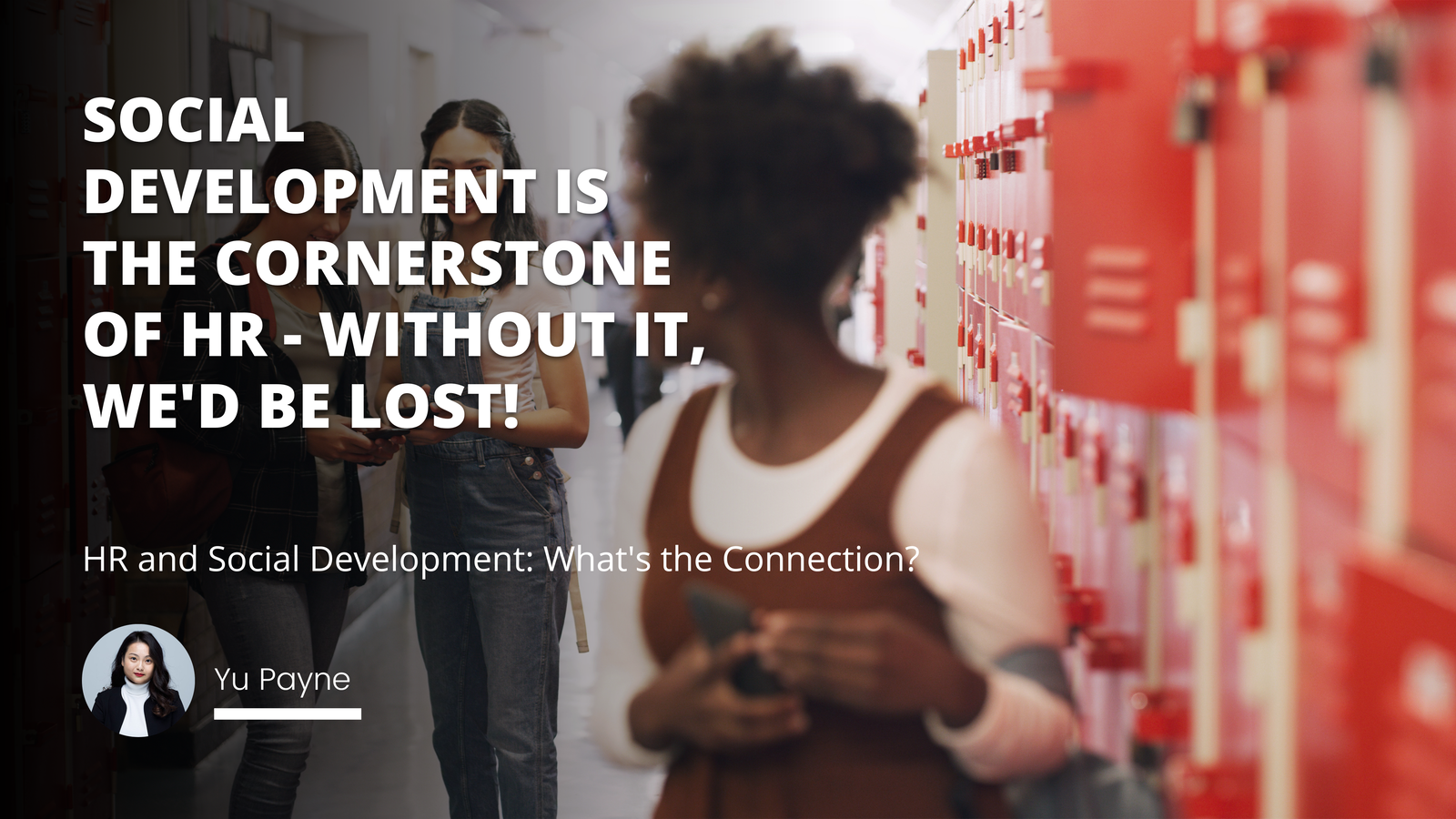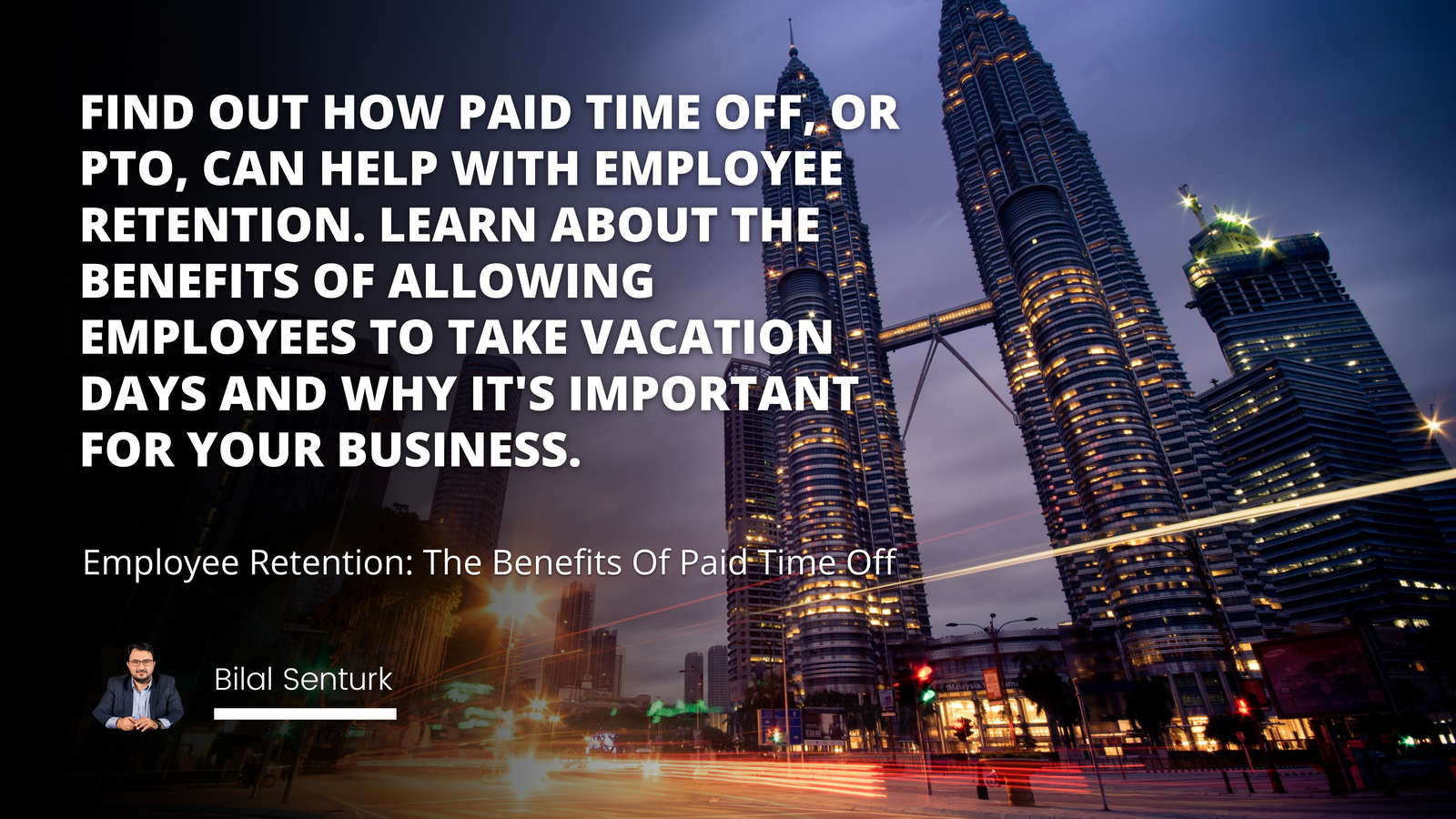
The concept of work-life balance has gained eminent traction in the discourse of human capital development and organizational productivity. This equilibrium pertains to an individual's ability to maintain a healthy division between their professional responsibilities and personal life. This harmony is not only pivotal for the individual’s well-being and productivity but is increasingly recognized by organizations as a cornerstone for operational success.
The burgeoning demand for a plausible balance between work commitments and personal life has triggered progressive alterations in workplace dynamics, employment patterns, and human resource management strategies.
Understanding the Modern Workplace
Changes in employment patterns and trends.
In recent years, the labor market has witnessed a seismic shift in employment patterns and trends. The once clear-cut boundaries between various work sectors and job roles have become increasingly fluid, as technological advancements and global competition drive the need for adaptive and multifaceted skill sets.
An understanding of these patterns is essential for employers to attract and maintain a talented workforce, while for employees, remaining agile is critical for professional longevity. Consequently, the modern career trajectory often features a blend of full-time roles, freelance gigs, and continuous professional development, such as undertaking a human resource management course.
The rise of remote working trends.
The advancement of digital technologies has been a catalyst for the widespread acceptance of remote working. Online platforms, cloud computing, and collaborative tools have revolutionized where and how people can work. These trends afford employees unprecedented flexibility, but they also create a challenge in delineating the boundaries between their professional and personal lives.
Despite the liberty to work from anywhere, employees may find themselves logged on well beyond traditional hours, blurring the lines and jeopardizing work-life balance.
The blurred boundaries between work and personal life.
Modern technology and remote work capabilities have generated an environment where work can pervade personal life. Smartphones and laptops mean that for many, the workday never truly ends. Notifications, emails, and the pressure to be constantly available have contributed to a culture of being 'always on', with potentially detrimental effects on work-life balance.
This phenomenon has been exacerbated by global events such as the COVID-19 pandemic, which imprinted a significant shift on the traditional office environment, necessitating work from home as the new norm for many industries.
The Impacts of Imbalance
The psychological and physical effects of poor work-life balance.
Work-life imbalance can have profound psychological and physical repercussions. Long hours and chronic stress without adequate respite can lead to burnout, anxiety, and depression. The physiology of stress also means that overworking can increase the risk of chronic conditions such as heart disease and diabetes.
The cumulative effect of sustained stress compromises not just the quality of an individual's work but their overall life satisfaction and health.
The effect of imbalance on relationships and family life.
A poor balance between work and personal commitments can also strain relationships, leading to familial discord and a sense of disconnect with loved ones. Prioritizing work above all else can result in missed milestones and a lack of presence in family and social circles, which can be especially detrimental to parent-child relationships. These effects amplify the need for concerted measures towards attaining work-life harmony.
Impacts on productivity and job satisfaction.
Work-life imbalance can paradoxically lead to decreased productivity at work. Exhaustion hampers concentration, creativity, and efficiency, undermining job performance. Moreover, when employees feel that their work is encroaching upon their personal time, it can lead to a decline in job satisfaction, increasing employee turnover rates. Studies provide empirical evidence linking inadequate work-life balance with diminished professional engagement and elevated instances of workplace burnout.
Balancing Act – Strategies for a Healthy Work-Life Balance
Self-awareness and setting boundaries.
The quest for work-life balance begins with self-awareness and the conscious effort to set boundaries. Self-regulation in managing time and workspace, particularly in a home setting, is essential to prevent work from spilling into personal life. Delineating work hours, creating a dedicated workspace, and being assertive in communicating availability to colleagues and superiors can safeguard personal time.
Time management strategies.
Time management is yet another crucial strategy in balancing the scales. Prioritizing tasks, setting realistic deadlines, and leveraging productivity tools can help individuals maximize efficiency during work hours, thereby preserving quality time for after-work activities. Managers and leaders can further this by emphasizing outcomes over the number of hours worked, aligning with a results-oriented work environment.
Prioritizing health and wellness.
Central to maintaining balance is prioritizing one's health and wellness. Regular physical activity, adequate rest, and balanced nutrition are essential for cognitive function and emotional resilience. Employers can play a supportive role by offering wellness programs, encouraging breaks, and respecting an individual's time off. Such initiatives not only promote health but also signal that an organization values its employees' well-being.
Employers and Work-Life Balance
Role of company policies in enabling work-life balance.
Progressive employers recognize that facilitating a healthy work-life balance is not solely the responsibility of the employees but is also rooted in company culture and policy. Institutionally, this includes developing policies that respect personal time, such as limiting after-hours work communication. Through comprehensive online courses and training on work-life strategies, organizations can educate both leaders and employees on balancing professional and personal lives effectively.
The benefit of encouraging work-life balance for employee retention and satisfaction.
Companies fostering a culture that promotes work-life balance are likely to see benefits in their retention rates and overall employee satisfaction. Employees who feel their personal time is respected tend to exhibit higher loyalty and dedication to their employer. This translates into a more contented, productive workforce, contributing to the company’s competitive edge in attracting and retaining talent.
Strategies like flexible working hours, paid time off, and wellness programs.
Businesses can employ strategies such as flexible working hours, the provision of paid time off, or even sabbaticals, as ways to help their workforce achieve balance. Wellness programs that focus on mental health and physical well-being are increasingly becoming a staple benefit offered by employers. When implemented thoughtfully, such measures have demonstrated significant positive impacts, as shown in case studies of companies that have successfully navigated the implementation of robust work-life balance policies.
In summary, work-life balance is an essential, multi-faceted aspect of contemporary working life. It influences individual wellness, productivity, and job satisfaction, as well as organizational success in a broader context. Both employees and employers have roles to play in crafting a work environment that supports balance, whether through self-management techniques or company-wide policies.
As the lines between work and personal life continue to blur, especially in an age of remote work and digital connectivity, the collective ability to navigate these complexities will increasingly become a critical indicator of professional and personal success.
Frequently Asked Questions
What are the primary challenges facing the modern workforce in maintaining a healthy work-life balance?
Modern Workforce Challenges
Maintaining a Healthy Work-Life Balance
The modern workforce faces significant challenges. Primary among these is maintaining work-life balance. This struggle stems from various factors. Technological advancements are one. They have blurred the lines between work and personal time. Employees can work anywhere, anytime.
- Constant connectivity leads to increased work hours.
- Mobile devices make escaping work difficult.
These conditions create a culture of "always on". People feel they must respond immediately. This pressure leads to stress. Failure to disconnect hinders relaxation. Over time, this can cause burnout.
- Stress impacts mental health.
- Burnout affects employee retention.
Family dynamics have also evolved. Dual-income households are now common. Balancing these professional commitments requires careful coordination. Childcare adds further complexity. These realities amplify stress.
- Dual-income homes are the norm.
- Childcare needs complicate schedules.
Economic factors play a role. Living costs have risen. Wages have not kept pace. Many feel compelled to work longer. Some take on second jobs. This leaves little time for rest.
- Cost of living pressures employees.
- Wages lag behind, forcing longer hours.
Employers often demand high performance. Targets and deadlines are aggressive. Cultures of competition prevail. They leave workers with little breathing room. This race for excellence is exhausting.
- Performance expectations are high.
- Competition in workplaces is fierce.
Solutions exist but require a joint effort. Employers must acknowledge the issue. They can offer flexible schedules. This can reduce stress. Work from home policies also help. Yet, they must include clear boundaries.
- Employers can offer flexibility.
- Boundaries are critical in remote work.
Government policies may provide support. Legislations can mandate maximum work hours. They can promote parental leave. They encourage more balance.
- Policies can limit work hours.
- Parental leave rules can help.
Challenges to work-life balance are complex. They demand attention from various stakeholders. The modern employee needs support. Without it, the cost is high. It includes mental health, family life, and overall well-being. The work-life balance struggle is real. Yet, with conscious effort, it is manageable.

How has the current global trend of remote work affected the work-life balance of employees, and what strategies can be implemented to improve it?
Remote Work and Work-Life Balance
The current global trend of remote work has notably shifted the dynamics of work-life balance. Employees find the boundaries between professional and personal life blurring. Flexibility, once a perk, now challenges many in maintaining structured daily routines. The constant connectivity enabled by technology can lead to longer hours. It adds pressure to always remain available for work concerns.
Impact on Employees' Lives
Remote work has freed employees from commutes. It allows for more family time. However, it also created new expectations for work availability. Many workers report feeling a need to prove their productivity. It can lead to overcompensation through more work hours. Remote work environments often lack clear end-of-day rituals. These signals used in office settings demarcate work time from personal time. Consequently, workers may struggle to disconnect. It may cause stress and lead to burnout.
Strategies to Improve Work-Life Balance
It becomes imperative for both employers and employees to act. The aim is to restore a healthy work-life balance in a remote setting. Below are strategies to improve this balance:
- Establish Clear Work Hours: Define start and end times. It allows employees to create a routine. It offers a structure similar to a physical workplace.
- Set Boundaries: Workers should designate a specific area as their office space. Work should not bleed into personal zones. It helps in psychologically separating work from home life.
- Prioritize Tasks: Encourage focusing on high-priority tasks. It can prevent overworking.
- Take Regular Breaks: Short breaks throughout the day can boost productivity. They can also reduce mental fatigue.
- Encourage Time Off: Employers must encourage employees to take their full leave entitlements. Time off is essential to recharge and avoid burnout.
- Promote Physical Activity: A routine for exercise can contribute to mental health. It can also provide a break from work-related thinking.
- Support Social Interaction: Virtual or in-person team activities can maintain connections. They can foster a sense of community among remote workers.
- Provide Resources: Employers should offer support for mental health. Resources can range from counseling services to stress management workshops.
- Use 'Do Not Disturb' Features: Advise the use of communication tools. They can signal coworkers when someone is unavailable.
- Regular Check-ins: Managers should regularly check in with their team. They can ensure workloads remain manageable.
Remote work has transformed the work-life equation. Without commutes and with increased flexibility, many benefits have arisen. Yet, it also introduced challenges to balancing work with personal life. Strategies focused on structure, boundaries, and well-being are critical. They can improve the remote work experience for employees. In this evolved work environment, adaptability remains crucial. So does the proactive pursuit of balance.

In what ways does a well-managed work-life balance contribute to individual productivity and overall organizational success?
Understanding Work-Life Balance
Work-life balance reflects individuals' efforts to split time and focus between work and personal life adequately. It remains a cornerstone of modern workplace discourse. This balance does not imply an equal split. Rather, it means allocating time, energy, and resources in a manner that fosters fulfillment in both areas. Employees strive for this equilibrium. Employers, on their part, should facilitate it. A well-managed work-life balance holds benefits for both the individual and the organization.
Individual Productivity
- Employee Well-being: Consistent overwork can lead to stress. This, in turn, may result in burnout. Burnout stifles creativity and productivity. A balanced work-life scenario promotes rest. Employees return rejuvenated. They are more prepared to handle work challenges.
- Increased Focus: Distractions often decrease when staff know they have time for personal activities. They focus better at work. This narrow focus often enhances the quality of output.
- Skill Development: Leisure time allows for personal development. Skills honed outside the office can prove beneficial within the workplace. These skills frequently include problem-solving and creativity.
- Health Benefits: Stress can cause a multitude of health problems. A work-life balance decreases stress. It leads to fewer health-related absences. This consistency aids productivity.
- Job Satisfaction: Satisfaction is key to employee engagement. Workers who achieve work-life balance tend to report higher job satisfaction. They usually show a greater commitment to their tasks.
Organizational Success
- Reduced Turnover: Job satisfaction and work-life balance can reduce staff turnover. Recruitment costs lower as a result. Morale often improves. A stable workforce can increase overall productivity levels.
- Attracts Talent: An emphasis on balance can make a company more attractive. Top talent often seeks this quality in employers. As such, the organization can capitalize on high-caliber staff.
- Innovation Thrives: Rested employees bring fresh ideas to the table. This environment can spur innovation. Innovative companies often outperform their competitors.
- Higher Engagement: Employees who feel balanced are typically more engaged. They invest more in their work. This commitment can yield better results and drive success.
- Positive Corporate Image: A business known for encouraging work-life balance is often well-regarded. This reputation can lead to customer loyalty. It may also attract investor interest.
Balancing work and life demands careful management. Employers must play a part in ensuring employee well-being. They should offer resources and support for achieving this equilibrium. Job design, flexibility, and company culture all contribute.
Let's acknowledge the individual's role as well. Employees must communicate needs and make use of offered supports. Self-care outside of work should not be an afterthought.
In conclusion, the benefits of a well-managed work-life balance are twofold. They enhance individual well-being and productivity. They also underpin broader organizational success. When both employer and employee invest in balance, the return is substantial. It extends beyond the office walls. It impacts overall business health and industry standing.



